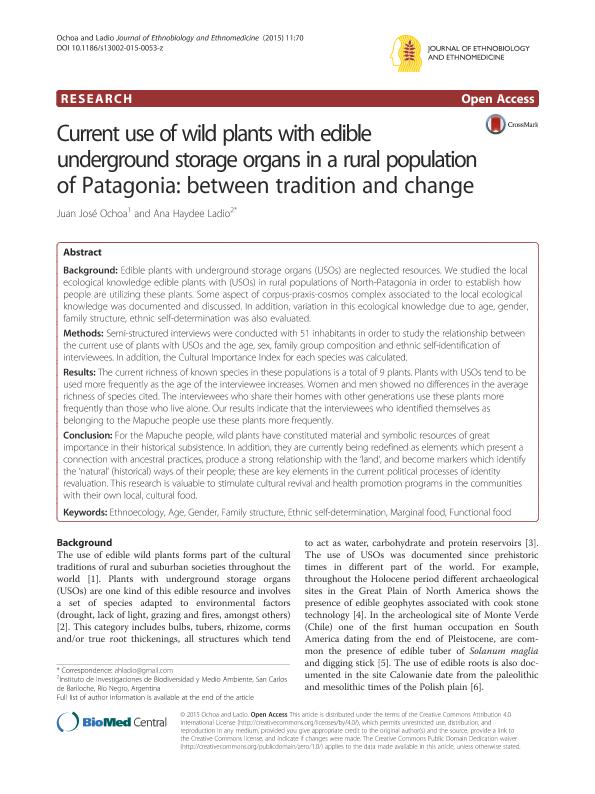Mostrar el registro sencillo del ítem
dc.contributor.author
Ochoa, Juan José

dc.contributor.author
Ladio, Ana Haydee

dc.date.available
2016-12-15T20:27:07Z
dc.date.issued
2015-09
dc.identifier.citation
Ochoa, Juan José; Ladio, Ana Haydee; Current use of wild plants with edible underground storage organs in a rural population of Patagonia: between tradition and change; BioMed Central; Journal of Ethnobiology and Ethnomedicine; 11; 70; 9-2015; 1-14
dc.identifier.issn
1746-4269
dc.identifier.uri
http://hdl.handle.net/11336/9477
dc.description.abstract
Edible plants with underground storage organs (USOs) are neglected resources. We studied the local ecological knowledge edible plants with (USOs) in rural populations of North-Patagonia in order to establish how people are utilizing these plants. Some aspect of corpus-praxis-cosmos complex associated to the local ecological knowledge was documented and discussed. In addition, variation in this ecological knowledge due to age, gender, family structure, ethnic self-determination was also evaluated. Methods: Semi-structured interviews were conducted with 51 inhabitants in order to study the relationship betweenthe current use of plants with USOs and the age, sex, family group composition and ethnic self-identification of interviewees. In addition, the Cultural Importance Index for each species was calculated. Results: The current richness of known species in these populations is a total of 9 plants. Plants with USOs tend to be used more frequently as the age of the interviewee increases. Women and men showed no differences in the average richness of species cited. The interviewees who share their homes with other generations use these plants more frequently than those who live alone. Our results indicate that the interviewees who identified themselves as belonging to the Mapuche people use these plants more frequently. Conclusion: For the Mapuche people, wild plants have constituted material and symbolic resources of great importance in their historical subsistence. In addition, they are currently being redefined as elements which present a connection with ancestral practices, produce a strong relationship with the ?land?, and become markers which identify the ?natural? (historical) ways of their people; these are key elements in the current political processes of identity revaluation. This research is valuable to stimulate cultural revival and health promotion programs in the communities with their own local, cultural food.
dc.format
application/pdf
dc.language.iso
eng
dc.publisher
BioMed Central

dc.rights
info:eu-repo/semantics/openAccess
dc.rights.uri
https://creativecommons.org/licenses/by-nc-sa/2.5/ar/
dc.subject
Ethnoecology
dc.subject
Age
dc.subject
Gender
dc.subject
Family Structure
dc.subject
Ethnic Self-Determination
dc.subject
Marginal Food
dc.subject
Functional Food
dc.subject.classification
Otras Ciencias Naturales y Exactas

dc.subject.classification
Otras Ciencias Naturales y Exactas

dc.subject.classification
CIENCIAS NATURALES Y EXACTAS

dc.title
Current use of wild plants with edible underground storage organs in a rural population of Patagonia: between tradition and change
dc.type
info:eu-repo/semantics/article
dc.type
info:ar-repo/semantics/artículo
dc.type
info:eu-repo/semantics/publishedVersion
dc.date.updated
2016-12-12T14:34:01Z
dc.journal.volume
11
dc.journal.number
70
dc.journal.pagination
1-14
dc.journal.pais
Reino Unido

dc.journal.ciudad
Londres
dc.description.fil
Fil: Ochoa, Juan José. Consejo Nacional de Investigaciones Científicas y Técnicas. Centro Científico Tecnológico Patagonia Norte. Instituto de Investigaciones En Diversidad Cultural y Procesos de Cambio; Argentina
dc.description.fil
Fil: Ladio, Ana Haydee. Consejo Nacional de Investigaciones Científicas y Técnicas. Centro Científico Tecnológico Patagonia Norte. Instituto de Investigación En Biodiversidad y Medioambiente; Argentina
dc.journal.title
Journal of Ethnobiology and Ethnomedicine
dc.relation.alternativeid
info:eu-repo/semantics/altIdentifier/url/http://ethnobiomed.biomedcentral.com/articles/10.1186/s13002-015-0053-z
dc.relation.alternativeid
info:eu-repo/semantics/altIdentifier/pmid/https://www.ncbi.nlm.nih.gov/pmc/articles/PMC4582829/
dc.relation.alternativeid
info:eu-repo/semantics/altIdentifier/url/http://dx.doi.org/10.1186/s13002-015-0053-z
Archivos asociados
